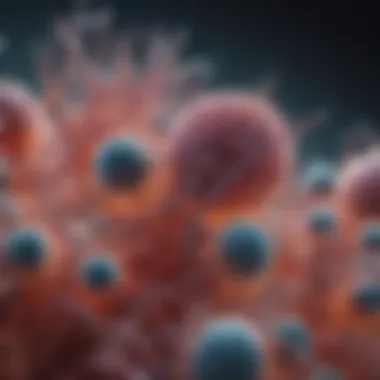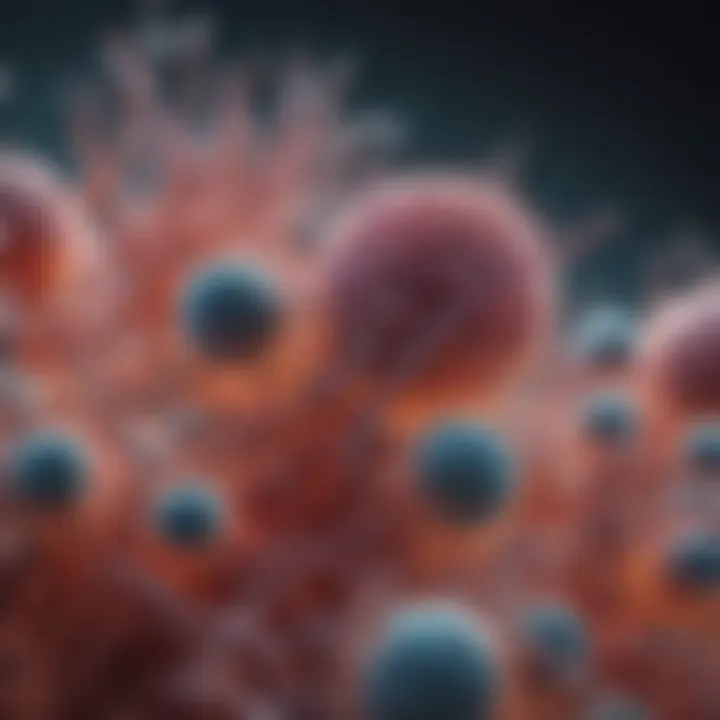Understanding Bacterial Resistance to Antibiotics


Article Overview
Purpose of the Article
This article aims to elucidate the complex mechanisms that underpin bacterial resistance to antibiotics. As antibiotic-resistant bacteria become more prevalent, it is essential to understand how these organisms adapt and survive when exposed to these medical treatments. The article delves into genetic mutations, horizontal gene transfer, and the consequences of antibiotic misuse that contribute to this growing issue. By presenting the intricate details of these processes, this piece seeks to inform readers about the pressing public health challenge posed by antimicrobial resistance.
Relevance to Multiple Disciplines
The topic stands at the intersection of various fields, including microbiology, medicine, public health, and pharmacology. Its implications are far-reaching, influencing treatment protocols in clinical settings, research priorities in laboratories, and policy decisions in healthcare systems. Understanding the dynamics of bacterial resistance is also vital for environmental scientists, as the spread of resistance is not restricted to clinical hospitals but extends to ecological systems.
Research Background
Historical Context
The phenomenon of antibiotic resistance is not new. The first antibiotics emerged in the early 20th century. Initially, these drugs had remarkable efficacy against bacterial infections. However, by the 1940s, resistance began to appear. This marked the beginning of an ongoing struggle between medical advancements and bacterial adaptability. The increasing overuse and misuse of antibiotics in medicine and agriculture have accelerated the development of resistant strains, posing a dire public health threat.
Key Concepts and Definitions
To comprehend bacterial resistance, it is crucial to grasp some key concepts:
- Genetic mutations: Random changes in a bacterium's DNA can lead to resistance. These mutations can occur naturally or be induced by environmental factors.
- Horizontal gene transfer: Bacteria can acquire resistance genes from other bacteria through processes like transformation, transduction, and conjugation. This capability enables rapid dissemination of resistance.
- Antibiotic misuse: Misprescribing, incomplete courses, and use of antibiotics in livestock farming contribute to resistance development. Understanding these concepts is vital to addressing the issue effectively.
"Bacterial resistance isn't just a medical problem; it is a complex issue involving biology, ecology, and society."
"Bacterial resistance isn't just a medical problem; it is a complex issue involving biology, ecology, and society."
Prelude to Antibiotic Resistance
Antibiotic resistance represents a significant and pressing issue in contemporary medicine. This phenomenon occurs when bacteria evolve mechanisms to withstand the effects of medications designed to kill them or inhibit their growth. Understanding this topic is critical as it affects not only individual patient outcomes but also public health at large. The implications of antibiotic resistance reach into every aspect of healthcare.
A Brief History of Antibiotics
The journey of antibiotics began in 1928 when Alexander Fleming discovered penicillin. This marked the start of a new era in medicine, enabling the treatment of bacterial infections that were previously fatal. As antibiotics became widely used, their effectiveness transformed medical practices, allowing for safer surgeries and proper management of infections.
However, by the 1940s and 50s, the emergence of resistant strains of bacteria was already noted. For example, Staphylococcus aureus began showing resistance to penicillin shortly after its introduction. This pattern continued as new antibiotics were developed, each time meeting with resistance from bacteria. Understanding this history is crucial to grasp how we have arrived at the current state of antibiotic resistance. The cycle of discovery and resistance highlights an ongoing battle between medical innovation and bacterial adaptation.
Understanding Antibiotic Resistance
Antibiotic resistance occurs due to several mechanisms, making it a complex field of study. Bacteria can acquire resistance through genetic mutations or through the transfer of resistance genes from one bacterium to another. Misuse and overuse of antibiotics accelerate this process. It is essential to understand that resistance does not mean immunity; it means that the commonly prescribed antibiotics no longer work effectively. This decline in antibiotic efficacy requires healthcare professionals to rely on broader and sometimes more toxic treatments, which can have significant health implications.
In essence, comprehending antibiotic resistance is fundamental to devising strategies for combating it effectively. Such understanding aligns closely with public health interests, emphasizing the need for responsible antibiotic use and enhanced infection control measures.
"The emergence of antibiotic resistance is a clear indicator of the need for better stewardship of antibiotics and more research into effective alternatives."
"The emergence of antibiotic resistance is a clear indicator of the need for better stewardship of antibiotics and more research into effective alternatives."
Mechanisms of Resistance Development
The mechanisms by which bacteria develop resistance to antibiotics are essential to understanding how this issue affects modern medicine. These mechanisms allow bacteria to survive even in the presence of drugs designed to eliminate them. The significance of studying these mechanisms lies in their implications for treatment options and public health strategies. By comprehending how bacteria resist antibiotics, we can devise better approaches to combat these resistant strains.
Genetic Mutations
Genetic mutations are a primary means through which bacteria adapt and survive exposure to antibiotics. These mutations can occur spontaneously and can significantly affect a bacterium's ability to produce proteins involved in antibiotic susceptibility.


Point Mutations
Point mutations refer to specific changes in a single nucleotide base in the bacterium's DNA. This form of mutation is a common method that bacteria utilize to develop resistance. A key characteristic of point mutations is their ability to create a quick response to antibiotics, which can be beneficial for bacterial survival. This rapid adaptation is often seen in species such as Staphylococcus aureus, where mutations in target genes lead to resistance against methicillin.
The unique feature of point mutations is their simplicity. They can take place naturally during DNA replication. This simplicity offers an advantage, as it requires fewer changes to produce a resistant variation of the bacterium. However, there are disadvantages. Sometimes point mutations can lead to reduced bacterial fitness, creating trade-offs that may limit their long-term success.
Insertion and Deletion Mutations
Insertion and deletion mutations involve the addition or removal of nucleotide sequences, which can lead to frameshifts in the genetic code. This can dramatically alter protein production. The contribution of these mutations to resistance is significant, as they have the potential to disrupt the function of proteins targeted by antibiotics. A notable example includes the Escherichia coli, where such mutations can affect efflux pumps that normally expel antibiotics.
The key characteristic of insertion and deletion mutations is their ability to create various changes in the genetic code, leading to diverse forms of resistance. These mutations can be beneficial by providing bacteria with new, adaptable traits that enhance survival in hostile environments. However, an inherent disadvantage is that these mutations can sometimes produce nonfunctional or harmful proteins, which could adversely affect bacterial viability.
Horizontal Gene Transfer
Horizontal gene transfer is another crucial mechanism for antibiotic resistance, allowing bacteria to obtain resistance genes from other bacteria. This method can spread resistance quickly within and across different bacterial species.
Transformation
Transformation involves the uptake of free DNA from the environment by a bacterium, which can then integrate into its genome. This ability to acquire genetic material gives bacteria access to new traits, including antibiotic resistance. A well-studied example is Streptococcus pneumoniae, which can absorb genetic elements from its surroundings.
A key characteristic of transformation is that it operates on a principle of genetic diversity. It allows unrelated bacteria to share beneficial traits. Its unique feature lies in the bacterium's environment; the presence of DNA from dead bacteria drives this mechanism. The advantage is clear: speed in acquiring resistance. A disadvantage, however, is that it is limited to bacteria that are naturally competent or have been artificially induced to take up DNA.
Conjugation
Conjugation is a process where genetic material is transferred directly from one bacterium to another through physical contact. This transfer typically involves plasmids, which are small circular DNA fragments. A key aspect of conjugation is its efficiency; it can rapidly spread resistance traits among bacterial populations.
The unique feature of conjugation is its ability to mobilize multiple resistance genes simultaneously, resulting in multiresistant bacteria. This is particularly concerning in clinical settings, where resistant strains can proliferate quickly. Though conjugation poses an advantage by ensuring diversity and adaptability, it may also lead to the formation of highly resistant bacterial populations, making treatment exceedingly difficult.
Transduction
Transduction involves the transfer of genetic material via bacteriophages, viruses that infect bacteria. This method can intentionally or accidentally introduce new genes, including those for antibiotic resistance, into bacterial cells. The significance of transduction lies in its ability to incorporate genetic changes without direct contact between bacterial cells.
A key characteristic of transduction is that it can propagate resistance genes across significant bacterial species barriers. The unique feature of this transfer method is that it utilizes viruses as vectors, which can lead to unexpected gene distribution. Advantages include the capacity for extensive gene exchange even outside of the typical bacterial interactions. However, disadavantages arise when resistant genes are not sufficiently maintained across generations, potentially leading to transient resistance.
Biofilm Formation
Biofilm formation is a process wherein bacteria adhere to surfaces and form complex communities. This structure serves as a protective barrier against antibiotics and the immune system. Understanding biofilms is vital for addressing persistent infections that traditional treatments often fail to eradicate. Bacteria such as Pseudomonas aeruginosa effectively employ biofilms, making them particularly challenging in clinical contexts.
Overall, the mechanisms of resistance development are multifaceted. They illustrate not only the adaptability of bacteria but also the ongoing challenges in treating bacterial infections. As research continues, the goal remains clear: to better understand these mechanisms to combat and mitigate antibiotic resistance effectively.
Factors Contributing to Resistance
The urgency of addressing bacterial resistance to antibiotics cannot be overstated. Understanding the factors that contribute to this resistance is essential for developing effective strategies to combat the issue. Several distinct elements fuel the rise of resistant strains of bacteria, significantly impacting public health. Key aspects include the overuse of antibiotics, their misuse in agricultural practices, and the lack of robust infection control measures in healthcare settings.
Overuse of Antibiotics
The overuse of antibiotics is a primary driver of resistance development. In many cases, antibiotics are prescribed unnecessarily for viral infections, which do not respond to these medications. According to recent studies, inappropriate prescriptions account for approximately 30% of all antibiotic use in outpatient settings. This excessive reliance creates an environment where bacteria are exposed to antibiotics frequently, allowing for selective pressure that favors resistant strains.
When antibiotics are misused in a clinical context, it leads to adverse consequences such as prolonged infections, increased healthcare costs, and higher mortality rates. Addressing the overuse problem requires enhanced clinical guidelines and education of both professionals and patients regarding the appropriate use of antibiotics.
Misuse in Agriculture
Another significant factor contributing to antibiotic resistance is their misuse in the agricultural sector. It is common practice to administer antibiotics to livestock to promote growth or prevent disease in healthy animals. The widespread use of these medications generates antibiotic-resistant bacteria, which can enter the human food chain through consumption of contaminated meat and other animal products.


Regulatory bodies have begun to scrutinize this practice, yet many regions still lack strict controls over antibiotic use in agriculture. The implications for public health are severe, as resistant bacteria can spread from animals to humans, complicating treatment options for infections. Raising awareness among consumers and advocating for responsible antibiotic use on farms are critical steps toward mitigating this risk.
Lack of Infection Control
Inadequate infection control measures in medical facilities also play a crucial role in the persistence and spread of antibiotic-resistant bacteria. Hospitals, long-term care facilities, and outpatient clinics frequently encounter situations where infections can spread rapidly, particularly if proper hygiene practices are not observed. Poor hand hygiene, insufficient use of personal protective equipment, and inadequate sterilization processes allow resistant bacteria to thrive and proliferate.
Implementing stringent infection control protocols helps reduce the risk of outbreaks caused by resistant strains. This includes ensuring that healthcare workers are educated on best practices, establishing rigorous cleaning regimens, and promoting vaccination to prevent infections in the first place.
"Mitigating antibiotic resistance requires a multifaceted approach encompassing clinical, agricultural, and healthcare settings."
"Mitigating antibiotic resistance requires a multifaceted approach encompassing clinical, agricultural, and healthcare settings."
In summary, the factors contributing to antibiotic resistance are interlinked and require comprehensive strategies to address effectively. Focused efforts to combat the overuse of antibiotics, reduce misuse in agriculture, and strengthen infection control measures are essential to curtail the spread of resistant bacteria and protect public health.
Consequences of Resistance
Addressing the consequences of antibiotic resistance is essential. This phenomenon has implications that stretch across public health systems and economic frameworks globally. In understanding the far-reaching impact of bacterial resistance, stakeholders can better prepare and implement effective strategies to mitigate its effects.
Impact on Public Health
The ramifications of antibiotic resistance on public health are severe. Infections that were once easily treatable now pose significant challenges. For healthcare professionals, the increasing prevalence of resistant infections leads to prolonged hospital stays, higher medical costs, and greater mortality rates. The Centers for Disease Control and Prevention (CDC) notes that at least 2.8 million people in the United States are infected with antibiotic-resistant bacteria each year, resulting in more than 35,000 deaths.
When bacteria become resistant to common antibiotics, standard treatments fail. This requires the use of more expensive and often less effective medications, putting additional strain on healthcare resources. Antibiotic resistance also complicates surgical procedures and therapies such as chemotherapy, exposing more patients to infections that are hard to treat.
Public health strategies must evolve to address these complexities. Enhanced surveillance of resistance patterns, promoting appropriate antibiotic use, and fostering research on new therapeutic options are necessary steps. The World Health Organization emphasizes these actions as crucial for maintaining effective healthcare systems in the face of growing resistance.
Economic Burden
The economic implications of antibiotic resistance are profound and multifaceted. Expenses arise from extended hospital stays, the need for more expensive drugs, and longer periods of treatment. According to a study published in the Journal of Medical Economics, the annual cost in the United States alone can reach billions due to increased healthcare costs associated with treating resistant infections.
- Direct costs include:
- Indirect costs reflect:
- Healthcare treatments for resistant infections.
- Additional diagnostic tests to identify resistant bacteria.
- Loss of productivity due to prolonged illness.
- Increased healthcare insurance premiums.
This economic strain does not just affect healthcare systems but extends to societies and economies worldwide. Governments may face increased tax burdens to cover the rising costs associated with treating infections and ensuring effective healthcare delivery.
"The consequences of antibiotic resistance are not merely clinical; they ripple through economies and societies, creating a burden that is both financial and medical."
"The consequences of antibiotic resistance are not merely clinical; they ripple through economies and societies, creating a burden that is both financial and medical."
In summary, the consequences of antibiotic resistance encompass critical public health challenges and significant economic burdens. Understanding these impacts is vital for anyone involved in healthcare, policy-making, or biomedical research.
Measures taken today can shape the future of how societies combat infections and allocate resources.
Research and Approaches to Combat Resistance
Research in the field of antibiotic resistance is crucial for maintaining effective healthcare practices. As bacteria develop resistance, the effectiveness of available antibiotics diminishes. This creates significant challenges in treating infections. Understanding the mechanisms behind resistance leads to emergent strategies that can modify or replace traditional antibiotics. Better approaches ensure the efficacy and longevity of current and future antibiotics.
Innovative Antibiotic Development
The development of new antibiotics is necessary to stay ahead of evolving bacterial strains. Researchers focus on discovering novel compounds that can effectively target resistant bacteria. Specifically, they are investigating natural products, synthetic compounds, and new formulations. One strategy involves modifying existing antibiotics to overcome resistance mechanisms. This innovation can lead to enhanced effectiveness against resistant strains.


Another key area is the use of combination therapies, using two or more antibiotics to synergize their effects against bacteria. The success of this approach relies on carefully selecting antibiotic pairs to maximize antibacterial effectiveness. By utilizing these innovative practices, healthcare can maintain a more robust arsenal against bacterial infections.
Alternative Therapies
Phage Therapy
Phage therapy utilizes bacteriophages—viruses that infect bacteria—to combat antibiotic-resistant infections. This approach is attractive due to its specificity. Phages can target and kill specific bacterial strains without affecting beneficial flora. This property makes it a promising alternative to traditional antibiotics.
A key characteristic of phage therapy is its adaptability. In the event of bacterial mutations, phages can be isolated and adjusted to ensure effectiveness. However, there are challenges, such as regulatory hurdles and the need for patient-specific treatments. Consequently, while phage therapy presents unique advantages, it must be further explored in clinical settings to validate its widespread application.
Immunotherapy
Immunotherapy aims to enhance the body’s immune response to fight off infections. This method can modulate immune pathways to improve the body's ability to detect and destroy resistant bacteria. A major focus of research is on monoclonal antibodies that specifically target bacterial pathogens.
One significant feature of immunotherapy is its ability to work in conjunction with antibiotics. By boosting the immune response alongside antibiotic treatment, this approach might reduce the reliance on antibiotics alone, thus minimizing resistance development. However, not all patients will respond equally to immunotherapy. Therefore, ongoing research is crucial to identify optimal therapies and target populations for its use.
The Role of Policy and Regulation
The role of policy and regulation in combating bacterial resistance to antibiotics is crucial. In a landscape where antibiotic misuse and overuse have contributed significantly to resistance, robust policies and regulatory frameworks are necessary to mitigate these trends. Policies can help ensure prudent antibiotic use in both healthcare and agricultural contexts. Furthermore, regulations can facilitate the monitoring and control of antibiotic prescriptions and usage patterns, creating a more responsible environment for antibiotic management.
Bacteria do not respect borders, making international cooperation vital. Hence, global health initiatives that promote antibiotic stewardship have become increasingly important. These initiatives aim to unify efforts across countries to combat resistance through coordinated strategies.
Global Health Initiatives
Global health initiatives strive to standardize practices regarding antibiotic use and promote research into alternative treatments. For example, organizations like the World Health Organization (WHO) advocate for the Global Action Plan on Antimicrobial Resistance. This plan encourages countries to develop their national action plans, integrating surveillance systems to track antibiotic use and resistance patterns effectively.
Moreover, public awareness campaigns are essential elements of these initiatives. They inform communities about the dangers of misusing antibiotics and the importance of completing prescribed treatments. Education can significantly influence behavior and reduce unnecessary demand for antibiotics.
Additionally, international collaborations are key. Partnerships can provide funding and technical support, allowing countries to implement best practices in prevention and management of resistance. Such collaborations can also help to hold companies accountable for the responsible marketing and use of antibiotics.
Regulatory Measures on Antibiotic Use
Regulatory measures are another vital aspect of addressing antibiotic resistance. These measures can include restrictions on over-the-counter sales of antibiotics, stringent guidelines for prescriptions, and bans on the use of certain antibiotics in livestock. Countries are increasingly recognizing the importance of these restrictions.
For instance, the European Union has implemented regulations limiting the use of antibiotics in animal husbandry. These regulations are aimed at reducing the overall consumption of antibiotics, thus lessening the selective pressure that leads to resistance.
- Monitoring and surveillance: Regular evaluation of antibiotic usage and resistance patterns is critical. Regulatory bodies must have mechanisms in place to monitor prescription practices and ensure compliance with guidelines.
- Reporting requirements: Mandatory reporting of antibiotic resistance data can enhance awareness and guide policy adjustments.
As regulations evolve, they must remain flexible to respond to emerging resistance patterns. Policymakers need to be informed by ongoing research and data to adapt strategies as necessary.
Effective policy and regulation not only protect public health but also ensure that antibiotics remain effective for future generations. In sum, with appropriate legislative frameworks and international collaboration, we can curb the growing threat of antibiotic resistance.
Effective policy and regulation not only protect public health but also ensure that antibiotics remain effective for future generations. In sum, with appropriate legislative frameworks and international collaboration, we can curb the growing threat of antibiotic resistance.
Ending
The discussion about bacterial resistance to antibiotics is pivotal in understanding the current landscape of infectious diseases. As resistant strains of bacteria continue to emerge, the implications for public health become increasingly perilous. Clinicians, researchers, and policymakers must synthesize knowledge on resistance mechanisms to navigate this complexity effectively.
Summary of Key Points
- Mechanisms of Resistance: Bacteria develop resistance through various mechanisms such as genetic mutations, horizontal gene transfer, and biofilm formation. Each mechanism contributes uniquely to the challenge of treating infections.
- Contributing Factors: The overuse and misuse of antibiotics, particularly in agriculture, are significant factors leading to increased resistance. Moreover, insufficient infection control practices exacerbate this issue.
- Consequences: The impact of antibiotic resistance is far-reaching, affecting public health and incurring substantial economic costs. Understanding these implications helps convey the urgency of addressing this crisis.
- Combat Strategies: Ongoing research into innovative antibiotic development and alternative therapies offers hope. Strategies such as phage therapy and immunotherapy show promise in combatting resistant bacteria.
- Policy and Regulation: Effective policies and regulations, including global health initiatives, play a crucial role in mitigating resistance. Awareness and adherence to these measures are essential for success.
Future Directions in Research
Future research must focus on a multifaceted approach to combat antibiotic resistance. Some key areas include:
- Novel Antibiotics: The continuous search for new antibiotics that can circumvent existing resistance mechanisms is critical. This includes exploring natural products and synthetic compounds.
- Genomic Studies: Investigating the genetic basis of resistance can reveal pathways for novel therapeutic targets. Understanding these genomic factors will guide tailored treatment strategies.
- Resistance Monitoring: Improved surveillance systems to track the emergence and spread of resistant strains are essential. Monitoring can help in implementing timely interventions.
- Public Awareness: Increasing public education on responsible antibiotic use is necessary. It helps bridge the gap between science and society, encouraging informed decisions around antibiotic prescriptions.
In summary, addressing bacterial resistance to antibiotics is complex and multifaceted. Continued research and collaboration among various sectors are imperative to developing effective solutions and safeguarding public health.



